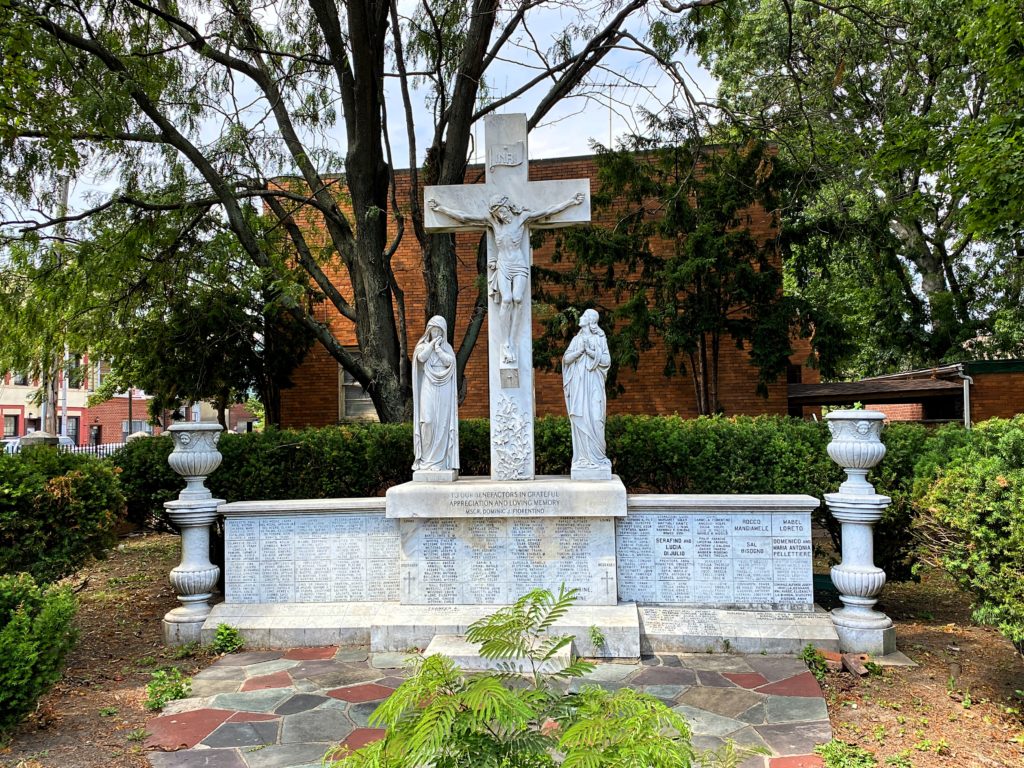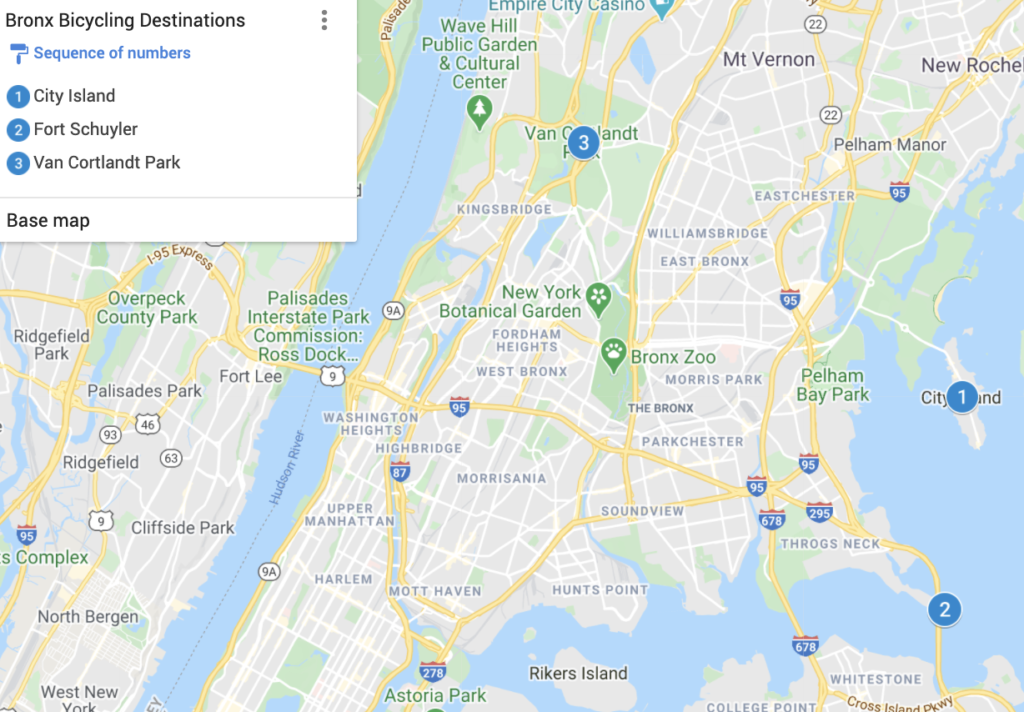New York City is a remarkable place to bicycle. There are five boroughs (Manhattan, Brooklyn, Queens, Bronx, and Staten Island), each with at least fifty distinct neighborhoods. While I’ve been restricted from international travel because of the Covid-19 pandemic, I continue to explore NYC by bike and am continually amazed by interesting places I somehow never went to or didn’t know, even though I’ve lived here most of my adult life.
The Bronx is next to the smallest borough at 42 sq mi / 109 sq km (about twice the area of Manhattan).

It’s also next to the smallest in population at about 1.4 million (about three times Staten Island’s). It’s the poorest with an average family income under $40,000 (half of Manhattan’s, the richest). About half of the residents are Hispanic and often there’s Latin music blaring on the streets.
When passing through the borough, two of the most prominent sights are the thousands of five-to-six-story tenement buildings and many amazing street murals. Here at 455 Jackson, the mural on the tenement features DJ Kamala created by British artist Richard Wilson.

The Bronx is known as a tough place, as you see from this video of vintage photography. Some of this reputation comes from the fires in the 1970s when over half of the housing stock in the South Bronx was burned, much from arson from landlords. There are many films about this calamitous times including the documentary “Decade of Fire” and “Fort Apache, The Bronx”, starring Paul Newman.
Highways were built until the 1970s, which tore apart many neighborhoods (much more so than in Queens and Brooklyn). Property near these highways plummeted in value and usually the poorest lived there. The worst example was the Cross Bronx Expressway, which bisected the borough, displaced over 1,400 families and caused a migration of middle-class residents to the north and left the south with pockets of intractable poverty. Here’s the beginning of the Cross Bronx in an entangled interchange with the Major Deegan Expressway.

Robert Caro’s masterpiece, “The Power Broker” describes the devastating effect on certain neighborhoods. However, the Bronx has improved dramatically since the 1970s and now many residents are afraid of rising rents because of gentrification.
While the Bronx has seen difficult times and still has issues, it continues to have incredible achievements. Perhaps it is most famous for being the cradle of hip-hop. It’s the home of the baseball’s New York Yankees, also known as the Bronx Bombers, which have won 27 World Series pennants. Here’s a 2007 picture of the old Yankee Stadium, which was replaced by one across the street in 2009.

Strategy of Biking in the Bronx
The Bronx is too big and diverse to see in a single bike ride. The best way is to pick a destination and go to a maps app and devise a route. Then check out the interesting places going and returning from your furthest stop.
Whenever possible, be sure to use bike lanes, as Bronx drivers can be unpredictable.
While it’s very unlikely for a biker to be mugged in the Bronx, there’s always a chance of it in a big city where you go through unfamiliar areas, especially if you are riding on an expensive bike and have a pricey camera. To minimize the already low probability of this happening, I highly recommend biking with a friend or two and only during the day. Also friends can help you if you have an accident or your bike breaks down. Here are my frequent biking partners, Nick and Joe.

There are some places where it’s better to take the subway, than ride to and park your bike outside for long hours, including the Bronx Zoo, Bronx Botanical Gardens and Woodlawn Cemetery.
About 40% of the Bronx’s population is foreign or Puerto Rican born. About half speak a language other than English at home. So when biking, be sure to engage with the local people from such diverse backgrounds. Most of the time, they will be happy to tell you about the neighborhood and their story.
Biking is a good exercise during the Covid-19 pandemic, as you are in the open air and almost always not close to anyone for even a few minutes. However, as long as this pandemic lasts, be sure to wear a mask and practice social distancing when you are off the bike.
Recommended Bike Route in the Bronx
This is a 16-mile route which would take two hours nonstop. However, plan to spend most of the morning and afternoon in order to fully appreciate the many neighborhoods and landmarks. This route will give a good flavor of the borough. Some of the pictures were taken before the Covid-19 pandemic, so there are no masks.

Randalls and Ward Islands
The route starts with the pedestrian/bicycle Ward Island Bridge at 102nd Street and the East River in Manhattan. After crossing the East River, you are in Randalls and Ward Islands (they used to be separate but were landfilled together). Follow Central Road north to a bike-lane bridge over the Bronx Kill waterway to an industrial area of the Bronx. For a while, you’ll be on the eastern side of the Bruckner Expressway, then from 141st Street on the western side of it on Southern Blvd.
941-7 Southern Boulevard
At the busy intersection of Southern Blvd, Hunts Point and East 163rd Street, at 941-7 Southern Boulevard, there’s a curved building built in 1912. It’s notable because there are two different versions of the Bronx Seal, both with a sun and an eagle.

Nearby at 961 and 1032 Southern Blvd, there are two former, grand movie theaters.
Mural Wall on 2100 Glebe Avenue
Continue for a few minutes on Southern Boulevard, then turn right on Westchester Avenue and ride under the elevated Bruckner Expressway to 2100 Glebe Avenue. Here is a wall of constantly changing murals presented by the TAG Public Art Project. This one was painted by SinXero, a well-known NYC artist.

Parkchester
The next destination is Parkchester, a planned middle-class community and shopping area built by the Metropolitan Life Insurance Company from 1939 to 1942. It’s an amazing complex of square, reddish-brown brick apartments in a park-like area.

The buildings have several terracotta animal and human figures, many made by sculptor Joseph Kiselewski.

While there, I met Dennis, a resident who looks in his 50s except for his gray hair and is actually 76. His family has good genetics as shown by his mother who lives on her own in Jamaica.

He explained when he moved into Parkchester, the majority of the residents were Jewish, Irish, Italian and Eastern Europeans. Like most places in NYC, Parkchester has had waves of immigrants. One of the latest are Bangladeshis; now African Americans are a majority of the residents. Dennis worked in downtown Manhattan (taking the nearby 6 Train) as a proofreader until after the 9/11 attacks, when there were staff reductions. To supplement his income, he has worked at the Macy’s store a few blocks away from his apartment.
This is a good place to take a break, maybe buy coffee and pastries and sit by the fountain.

West Chester Square-East Tremont Avenue Train Station
The next stop is the 6 Train station at Westchester Square. On the staircase to the street you’ll find the “City of Glass”, a stained-glass piece of tenements and skyscrapers conceived by Romare Bearden. He proposed the work in 1982 and the fabricators completed it after he died in 1988.

Little Yemen
Through a series of streets in the Morris Park neighborhood, which has a preponderance of brick and vinyl-sided, one-to-three family houses, there’s Little Yemen on White Plains Road and Rhinelander Avenue. This is a recently created moniker for the few blocks with hookah restaurants and shops selling Middle Eastern goods.

Memorial to Monsignor Domenic Fiorentino
Also in Morris Park, by Van Nest Park and the Morris Park Boxing Club, is an elaborate statuary for benefactors of St. Dominic’s Church in memory of its founder, Monsignor Domenic Fiorentino. He was a young Italian immigrant, who started this church in 1924 and remained the pastor for 55 years. Throughout the Bronx, there are many Roman Catholic churches and homes with Christian shrines.

River Park
Located at the southern end of the Bronx Zoo is a small park with a playground and a view of a cascade on the Bronx River. It’s a little bit of nature in the urban expanse. The local area is called West Farms and is a reminder that not so long ago, in the early 1800s, that the Bronx was mainly wheat and livestock farms.

Here I am with my recently purchased Cannondale Synapse road-bike, which I bought from the Westchester Bicycle Pro Shop in the Bronx. This is a fantastic, lightweight, 22-gear bike which makes riding so much easier than my old Raleigh hybrid-bike which I used for 20 years.
Bronx Little Italy
After all this exploring, Little Italy is a good place to stop for food. Many of the restaurants have outside seating, so you can eat safely during the pandemic. Italians started living here in the late 1800s and dominated the area by 1900. It was better living than the crowded Manhattan Little Italy and many could work as stonemasons and landscapers at the nearby New York Botanical Garden and the Bronx Zoo. Starting in the 1970s, many Italian families moved out and were replaced by Hispanics, Albanians and other groups. The restaurants still serve the standard Italian cuisine of pasta, sausage and other dishes flavored by marinara sauce, parmesan cheese and peppers, accompanied by a large selection of wines. After eating, you can enjoy a delicious espresso or cappuccino.
My wife, Khadija, and I have sampled a few of the restaurants and a favorite is Enzo’s.

The High Bridge
If you made it this far, it’s probably time to return to Manhattan. It takes 20 to 30 minutes, on some steep hills, to reach the High Bridge, open only to pedestrians and bicyclists. There are great views of the Harlem River and the Manhattan skyline. Also you can often run into interesting folks here, such as Daniel and Inna dancing the bachata.
Other Bronx Destinations
Here are three other destinations you can bike to.

City Island, in the northern Bronx, is an enclave with many seafood restaurants and good views of Manhattan. There are boats everywhere, some you can sail or just watch from many points on the shoreline.

Fort Schuyler, under the Throgs Neck bridge to Queens, began operations in 1845 to defend the shipping routes on the East River and Long Island Sound. In the 1930s, the U.S. Army left the base and it was converted to the campus of the New York State Merchant Marine Academy. The Fort is also the home of the Maritime Industry Museum and a pleasant place to bike. While there, check out the suburban-like village of Throgs Neck and have a coffee or burger.

Van Cortlandt Park is NYC’s third largest park with numerous trails for bikers, runners, walkers and even horses. Here you can watch cricket, soccer and softball. Because there are so many sections of natural terrain, it’s a favorite place for bird watchers. Here’s a map of the park from NYC Department of Parks & Recreation.

Final Thoughts
Once you bike through the gritty Bronx, you can decide if it lives up to its reputation. If you are drawn to the borough, there are plenty of interesting bike routes.

If biking there is too chaotic for you, then taking the subway is an option.

However you go there, I suggest you check out this unique urban landscape with a plethora of cultures.


